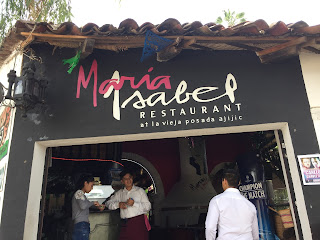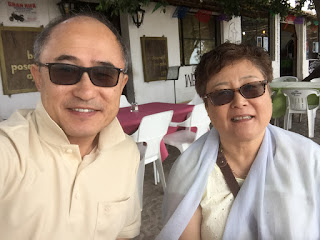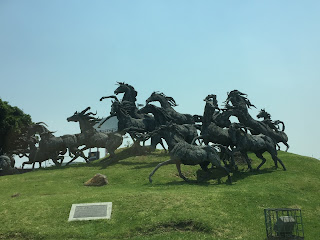While Kristin and I were visiting the U.S. in April, we took a side trip to Ajijic, Mexico. It was for our 34th anniversary and at the same time an exploring trip if it is suitable for a retirement residence. It is a small town located by the Mexico's largest lake, Lake Chapala, in the Province of Jalisco. It is located within one hour drive from the second largest city Guadalajara and the airport is between Guadalajara and Lake Chapala.
Our journey began with a fiasco. Our arrival was late or too early at 1:10am. We took a taxi and checked into a casita, a guest house within a large house compound. Michelle was the host and she was willing to wake up and get up to open the house for us at around 3:00am. How hospitable she was! But the plane landed almost 40 minutes early and we were able to clear through the immigration pretty fast. So we arrived at around 2:10am. We washed and fell into sleep. At around 3 am, Kristin heard someone trying to break in. She shouted "Who is it?" and the other person shouted back: "What are you?" It was Michelle. She was looking for a house key before we arrived and found the door was locked. What happened was that the house guard opened the door when we rang a bell. At any rate, our encounter happened awkwardly in the middle of the night, but Michelle was a great Airbnb host. For five nights, we paid a total of $172 that includes not only the payment for the one bed room house with a functioning kitchen, but also cleaning fee and Airbnb fee. Not bad at all. The taxi fare from the airport to this house was M$420 or $12.
Ajijic: Lake Chapala is located at 5,200 feet high. Ajijic is the center of North American expats, but a lot of expats also live in Lake Chapala, name of another town, San Antonio and Jocotepec. Michelle's house was located in San Antonio, a suburb of Ajijic. Ajijic has Sierra Mountain in the back and Lake Chapala in the front. Because of the mountain, Ajijic enjoys a microclimate of its own, which is cooler than other neighboring towns, approximately 10 degrees in F.
We first visted Lake Chapala Society in Ajijic. Apparently one of the expats donated his house to be used for this society and it functions as the gathering place for all expats through membership. It has a library and a video library. It also provides programs to teach English for residents and also to teach yoga and other extracurricular activities for the expats. At the information desk was a former judge from Canada who retired at 70 and is still active at 80. He had a medical condition that required a surgery but he will never return to Canada for any medical treatment. He was happy to be down there. We also met briefly with a woman, named Amanda, who we thought was a man until she told us that she was a woman. She was huge and we could not tell her gender based on anything. Interesting people...
Nearby the society are main streets full of merchants, restaurants and cafes. We walked around and dined at a few restaurants to try out. Tango Restaurant was quite appealing with excellent service and food. We also dined at Maria Isabel Restaurant. It has a lake view right at the restaurant. The food was okay and the mariachi band was quite disturbing honestly speaking.
As recommended, we visited Charter Club Travel Agency and booked for a day trip to Guadalajara.
Lake Chapala: We explored the malecons or boardwalks of Ajijic and Lake Chapala. Jocotepec also had a small malecon, but quite small. Ajijic had the best decorated malecon. But Lake Chapala had a beautiful sign of Lake Chapala and a town access right next to the pier. Water fountain was refreshing and sculptures were beautiful. Many tour boat owners were soliciting customers. But it was far too hot to be exposed on the water.
Jocotepec: We traveled to Jocotepec by bus and perhaps it was too early to see any action, but it was a quiet small town. Only a few shops were there and the malecon was rather small. We figured that Jocotepec town could be larger than other towns as some people explained. But we decided to skip to travel to the town of Jocotepec.
San Antonio: The place we stayed was in San Antonio and was close to Walmart. We took buses to travel to Lake Chapala and Jocotepec in front of Walmart. Later, we departed for Guadalajara in front of a coffee shop located across the street from Walmart. Apparently, San Antonio and the surroundings of Walmart were becoming one of the hubs for the expats connecting Ajijic and Lake Chapala.
The towns on the north shore of Lake Chapala, called the Lake Side, swell in population during the winter season, from November to March, due mainly to the snowbirds who come down to live through the winter in the north. Since the demand rises, the price of the housing also rises. Many people rent, but also many people own and use part of the year for renting out for the unused period of time.
Guadalajara: The day trip began at 9am. With another couple who are from Seattle, Washington, we traveled to Guadalajara. This city comprises 5 cities or munisipalities, with the total population reaching 5 million people. Guadalajara therefore is the name of the capital city of the Jalisco Province, and the name of the metropolitan area. Along the way, there are many plants. The driver mentioned IBM, Honda and several other familiar names.
Guadalajara is located at 5,000 feet or 1,500 meter in altitude. Its main industries include leather, electronic parts, wood craft work, of course Tequila. Along with Tequila, Mexican Mariachi Band was born in the Province of Jalisco. Wherever you go, you will encounter mariachi bands. Some are good but you will also meet amateur mariachi bands at best.
Miguel Hidalgo was a Roman Catholic priest, but he is considered the father of Mexico's War of Independence. Wherever you go, you will see the name Hidalgo or his statue or his museum. Guadalajara was not an exception. He was a Spanish priest, but born in Mexico. He led a movement that eventually led to Mexico's independence.
There is Roman Catholic Cathedral at the center of the city and there are four squares, forming a cross in an aerial view from above. The four squares are Guadalajara Square, Rotonda Square, Liberation Square and Constitution Square (better known as Plaza de Armas). The Governor's Palace is right next to the Plaza de Armas and Opera House is located at the tail end of the Liberation Square, leading to a huge indoor market. We thought we could buy almost anything in there. I bought a small handbag for man, made of leather. It set me back $16. Not bad.
We also drove around a few other places in the city. There were a lot of art works all over the city. A sculpture of horses was impressive and an outdoor art exhibit at a roundabout was showing the works of many local artists. A house nearby proudly exhibited a lot of sculptures at the rooftop of the house.













































No comments:
Post a Comment